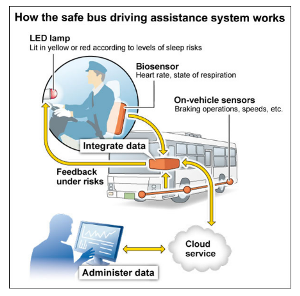Jan 18 2017
Amid a series of deadly accidents caused by drivers falling asleep or being inattentive at the wheel, researchers have developed a monitoring system to warn anyone in danger of dozing off.
 Credit: The Asahi Shimbun
Credit: The Asahi Shimbun
The technology, developed by researchers including those at Osaka Electro-Communication University and Kyoto Sangyo University, is being tested aboard fixed-route buses operating in Kobe.
Data is being collected through January from sensors mounted on 30 buses operated by Kobe Minato Kanko Bus Inc.
To monitor the state of drowsiness and attentiveness, the team of researchers developed a flat biosensor to be installed on the back side of the backrest of a driver’s seat that can measure, by microwaves, the state of respiration and the heart rate of drivers without touching their bodies.
“We are hoping to accumulate ‘big data’ in preparation for allowing a broad-based use of our system,” said Tsuneo Jozen, a professor of information engineering with Osaka Electro-Communication University.
The device offers drivers less discomfort than a sensor that has to be in contact with the skin, such as a wristwatch-shaped sensor or a sensor to be worn on an earlobe, the developers said.
When the respiration rate or the heart rate of the driver falls short of a threshold value, the system, in recognition of enhanced risks of sleep or other conditions setting in, issues an alert via a light-emitting diode lamp in front of the driver’s seat in yellow or red, according to the risk level.
The system also allows information from biosensors to be integrated on a network platform with information on vehicles, such as their locations, speeds and braking operations, and with other information, including the number of lanes on a road and past driving records, to identify locations at a high risk of accidents.
The system further allows warning issuance thresholds to be explored on a road-by-road basis, because researchers say drivers have varying heart rates when they are on expressways and on roads in urban areas.
The system could also allow the physical conditions of drivers to be monitored at an office of a bus company.
“If it were to become possible to spot abnormal conditions in a driver during a long-distance run, say, at the wheel of a sightseeing bus, that would allow us to order the driver to be replaced,” said an official with Kobe Minato Kanko Bus. “We hope to bring the study, eventually, to the creation of a system that would allow the brakes to be automatically applied in the event of a sudden illness.”